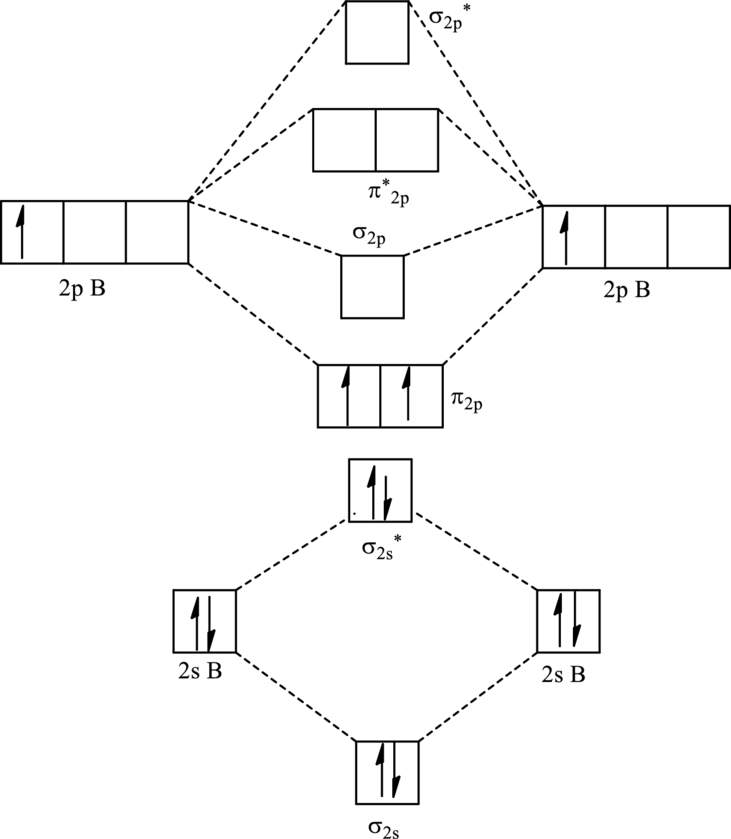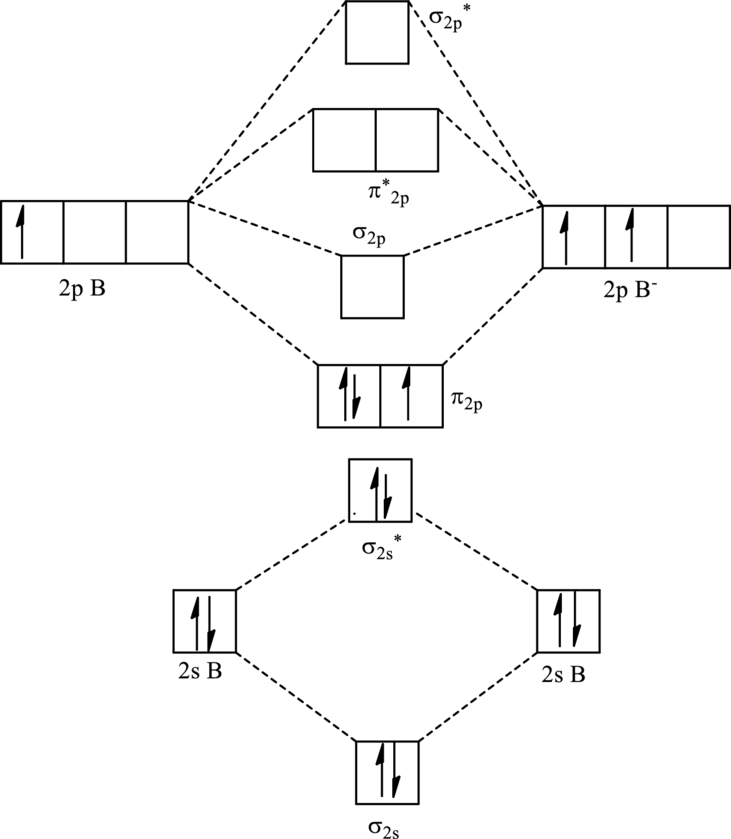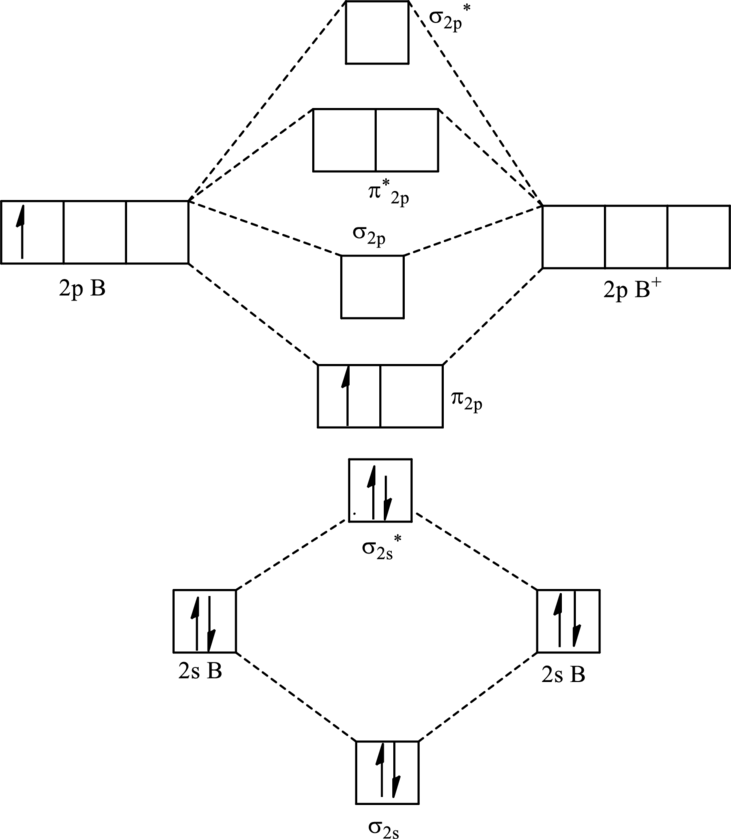
Concept explainers
(a)
Interpretation:
Bond order with molecular orbital diagram of
Concept Introduction:
Molecular orbital diagram is a linear combination of atomic orbitals of similar energy and similar symmetry. It is formed by the proper overlap of the atomic orbitals.
There are 3 types of molecular orbitals as follows:
- 1. Bonding molecular orbital: They are formed by the constructive interference of atomic orbitals and electrons in it stabilize the molecule and are of lesser in energy.
- 2. Antibonding molecular orbital: This type of orbitals increases the energy of molecule and destabilizes it and weakens the bond between the atoms.
- 3. Non-bonding molecular orbital: These types of orbitals have energy similar to atomic orbitals that is addition or removal of electron does not change the energy of molecule.
The order of energy in molecular orbital follows two rules as follows:
- 1. For
atomic number less than or equal to 14 order of energy is,
- 2. For atomic number more than 14 order of energy is,
Bond order
Species with number of unpaired electrons in its subshell is called paramagnetic species.
(a)
Answer to Problem 2G.2E
The molecule
Explanation of Solution
For
The symbol for boron is
Thus total valence electrons are sum of the valence electrons for each atom in
Hence, 6 electrons are to be arranged in each molecular orbital. Therefore, the molecular orbital diagram of

The electronic configuration of
Substitute 4 for number of electrons in bonding orbitals and 2 for number of electrons in antibonding orbitals in equation (1) to calculate bond order.
The molecular orbital diagram of
(b)
Interpretation:
Bond order with molecular orbital diagram of
Concept Introduction:
Refer to part (a).
(b)
Answer to Problem 2G.2E
The molecule
Explanation of Solution
For
The symbol for boron is
One negative charge is added up in a total valence count.
Thus total valence electrons are sum of the valence electrons for each atom in
Hence, 7 electrons are to be arranged in each molecular orbital. Therefore, the molecular orbital diagram of

The electronic configuration of
Substitute 5 for number of electrons in bonding orbitals and 2 for number of electrons in antibonding orbitals in equation (1) to calculate bond order.
The molecular orbital diagram of
(c)
Interpretation:
Bond order with molecular orbital diagram of
Concept Introduction:
Refer to part (a).
(c)
Answer to Problem 2G.2E
Explanation of Solution
For
The symbol for boron is
One positive charge on molecule is subtracted from total valence count.
Thus total valence electrons are sum of the valence electrons for each atom in
Hence, 5 electrons are to be arranged in each molecular orbital. Therefore, the molecular orbital diagram of

The electronic configuration of
Substitute 3 for number of electrons in bonding orbitals and 2 for number of electrons in antibonding orbitals in equation (1) to calculate bond order.
The molecular orbital diagram of
Want to see more full solutions like this?
Chapter 2 Solutions
CHEM PRINCIPLES LL W/ACHIEVE ONE-SEM
- 8:17 PM Sun Mar 30 Draw the major product of this reaction. Ignore inorganic byproducts. HSCH2CH2CH2SH, BF3 Probler Drawing Ato Bonds Clarrow_forwardpresented by Mr L How the coprion. (Il Done in no wraction, dew the starting redential) доarrow_forward8:16 PM Sun Mar 30 K Draw the major product of this reaction. Ignore inorganic byproducts. Proble 1. CH3MgBr 2. H3O+ F Drawingarrow_forward
- о но оarrow_forwardName the major organic product of the following action of 4-chloro-4-methyl-1-pentanol in neutral pollution 10+ Now the product. The product has a molecular formula f b. In a singly hain, the starting, material again converts into a secule with the molecular kormula CIO. but with comply Draw the major organic structure inhalationarrow_forwardMacmillan Learning Alcohols can be oxidized by chromic acid derivatives. One such reagent is pyridinium chlorochromate, (C,H,NH*)(CICTO3), commonly known as PCC. Draw the proposed (neutral) intermediate and the organic product in the oxidation of 1-butanol by PCC when carried out in an anhydrous solvent such as CH₂C₁₂. PCC Intermediate OH CH2Cl2 Draw the intermediate. Select Draw Templates More с H Cr о Product Draw the product. Erase Select Draw Templates More H о Erasearrow_forward
- If I have 1-bromopropene, to obtain compound A, I have to add NaOH and another compound. Indicate which compound that would be. A C6H5 CH3arrow_forwardProvide the reagents for the following reactions.arrow_forwardIf I have 1-bromopropene, to obtain compound Z, I have to add two compounds A1 and A2. Indicate which compounds are needed. P(C6H5)3arrow_forward
- Draw the major product of this reaction. Ignore inorganic byproducts. Assume that the water side product is continuously removed to drive the reaction toward products. O CH3CH2NH2, TSOH Select to Draw >arrow_forwardPredict the major organic product(s) for the following reaction.arrow_forwardPredict the major organic product(s) for the following reactions.arrow_forward
 Chemistry: Principles and ReactionsChemistryISBN:9781305079373Author:William L. Masterton, Cecile N. HurleyPublisher:Cengage Learning
Chemistry: Principles and ReactionsChemistryISBN:9781305079373Author:William L. Masterton, Cecile N. HurleyPublisher:Cengage Learning Chemistry & Chemical ReactivityChemistryISBN:9781337399074Author:John C. Kotz, Paul M. Treichel, John Townsend, David TreichelPublisher:Cengage Learning
Chemistry & Chemical ReactivityChemistryISBN:9781337399074Author:John C. Kotz, Paul M. Treichel, John Townsend, David TreichelPublisher:Cengage Learning Chemistry: Principles and PracticeChemistryISBN:9780534420123Author:Daniel L. Reger, Scott R. Goode, David W. Ball, Edward MercerPublisher:Cengage Learning
Chemistry: Principles and PracticeChemistryISBN:9780534420123Author:Daniel L. Reger, Scott R. Goode, David W. Ball, Edward MercerPublisher:Cengage Learning
 ChemistryChemistryISBN:9781305957404Author:Steven S. Zumdahl, Susan A. Zumdahl, Donald J. DeCostePublisher:Cengage Learning
ChemistryChemistryISBN:9781305957404Author:Steven S. Zumdahl, Susan A. Zumdahl, Donald J. DeCostePublisher:Cengage Learning Chemistry: An Atoms First ApproachChemistryISBN:9781305079243Author:Steven S. Zumdahl, Susan A. ZumdahlPublisher:Cengage Learning
Chemistry: An Atoms First ApproachChemistryISBN:9781305079243Author:Steven S. Zumdahl, Susan A. ZumdahlPublisher:Cengage Learning





